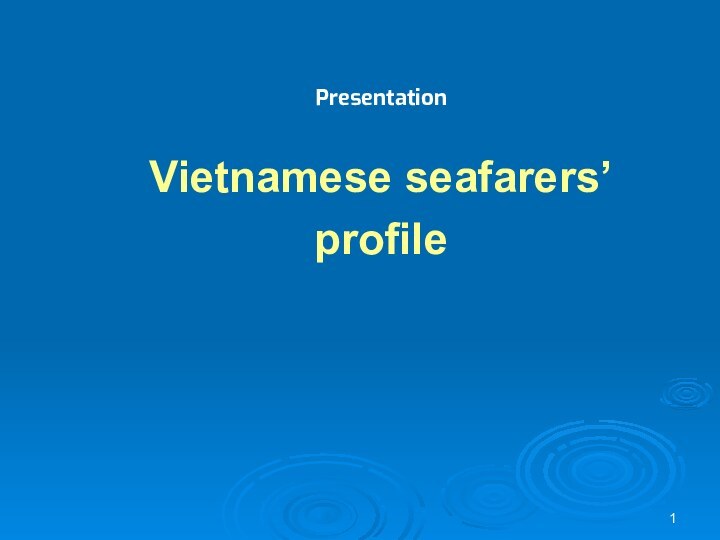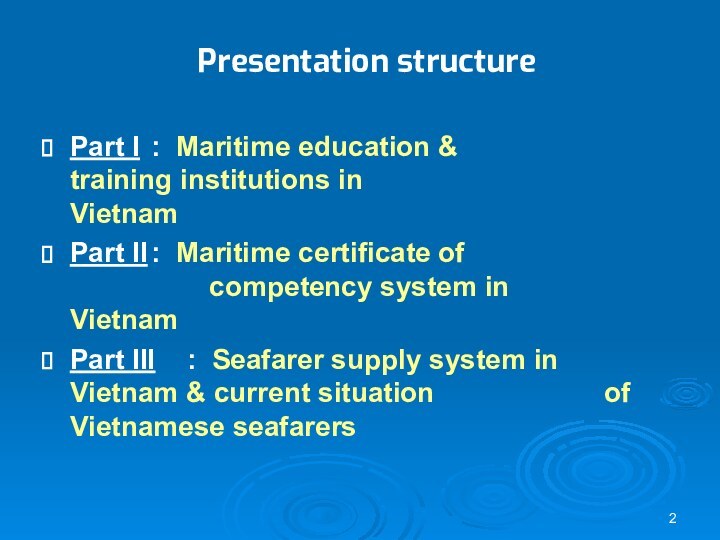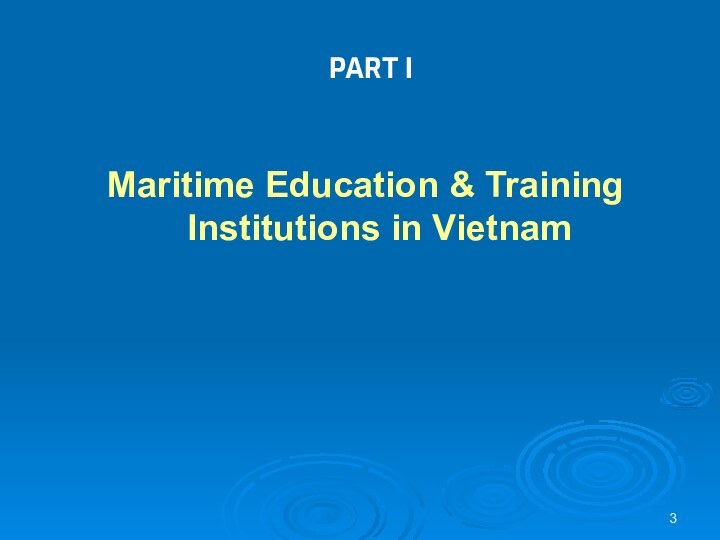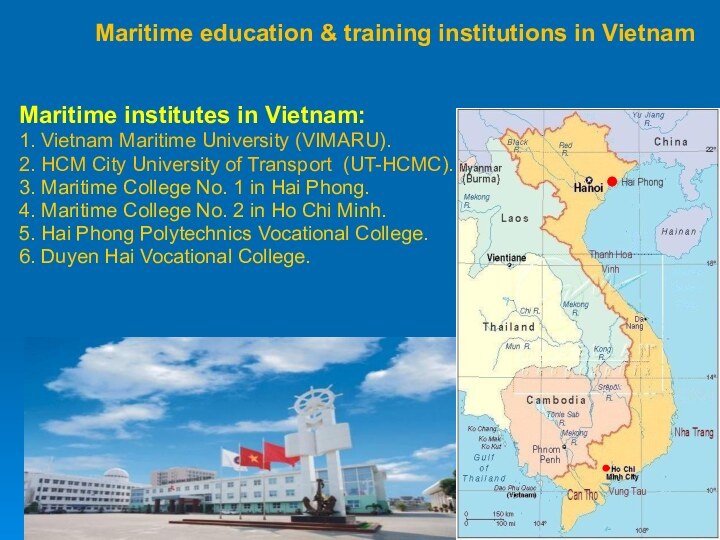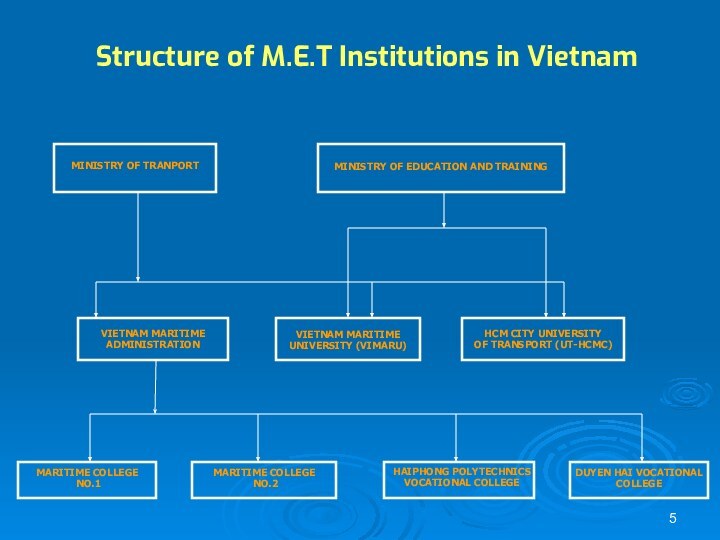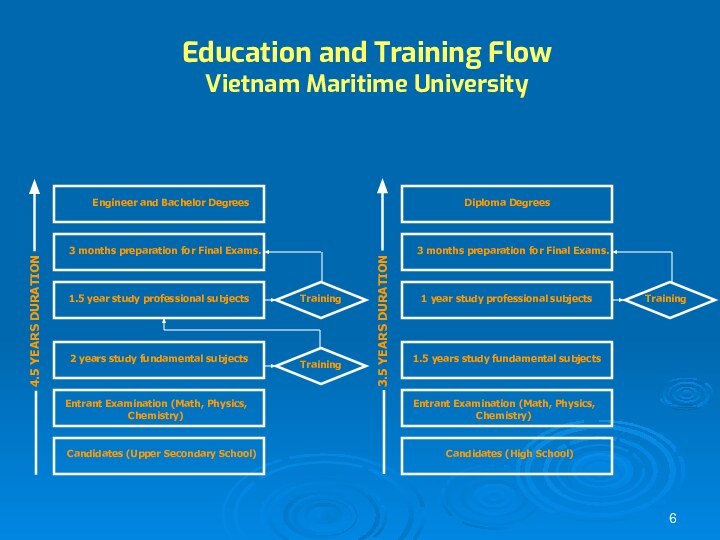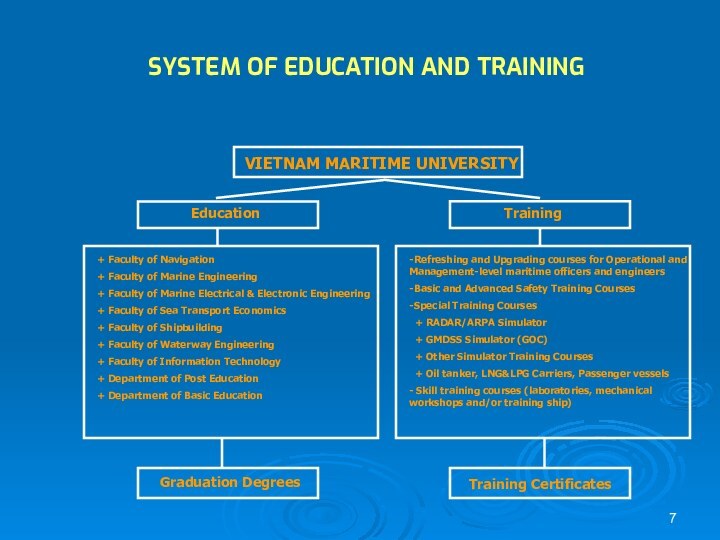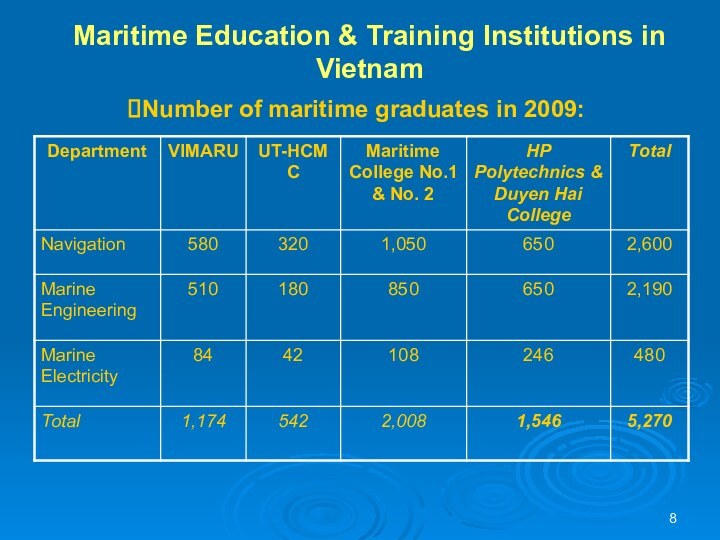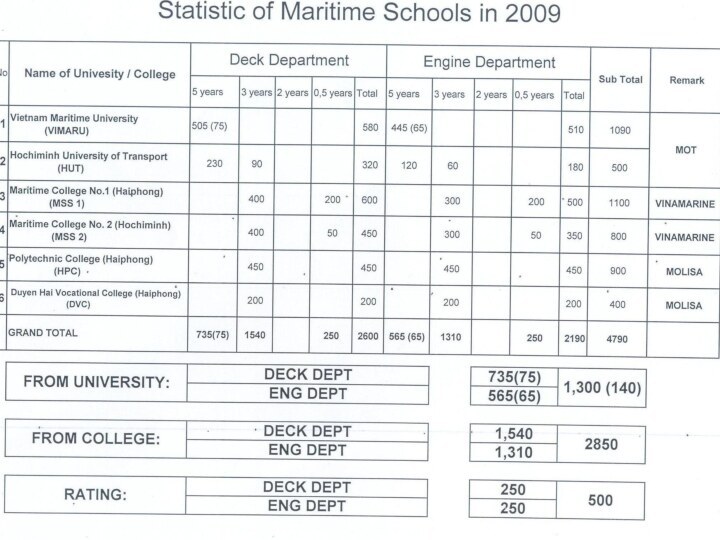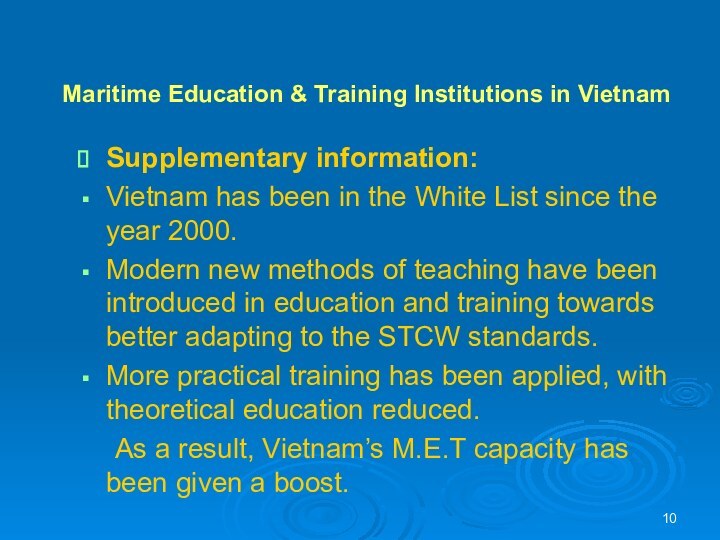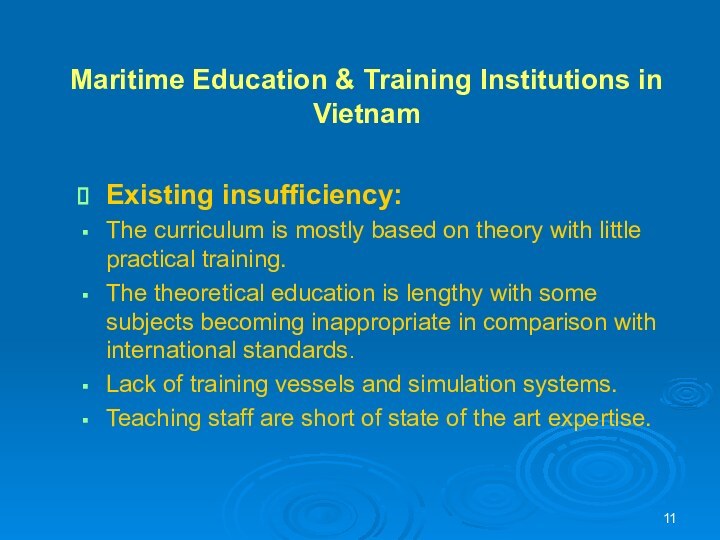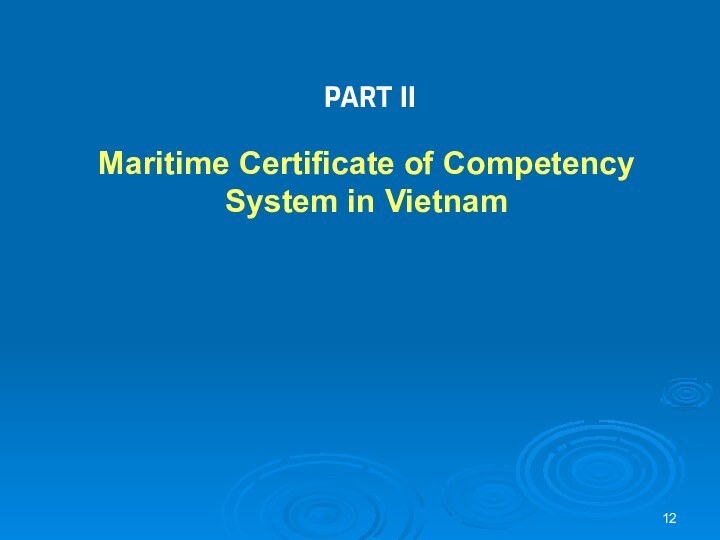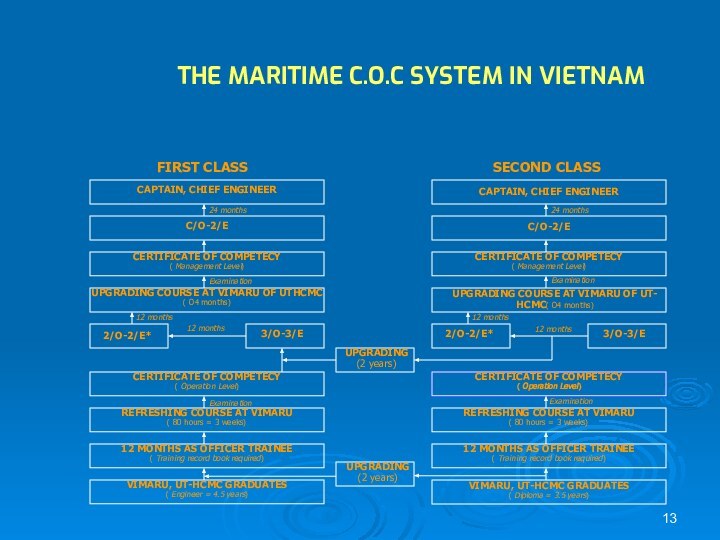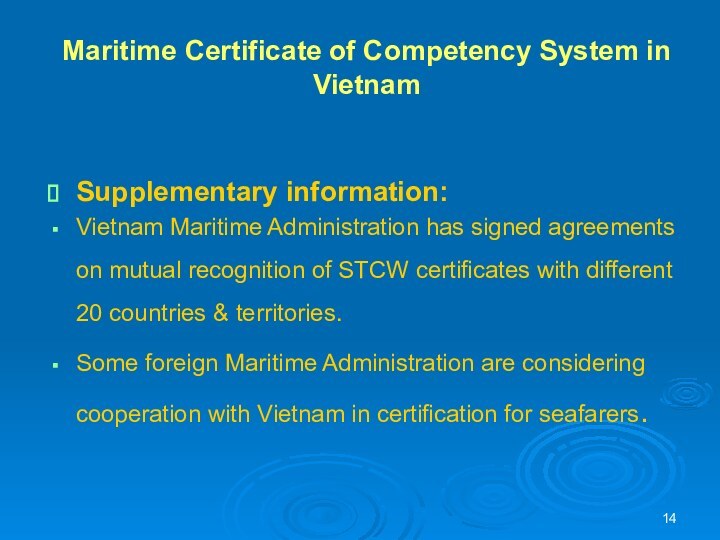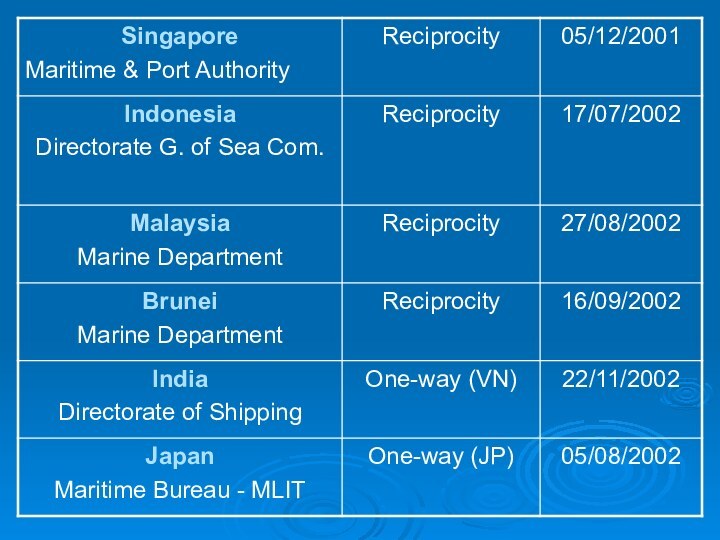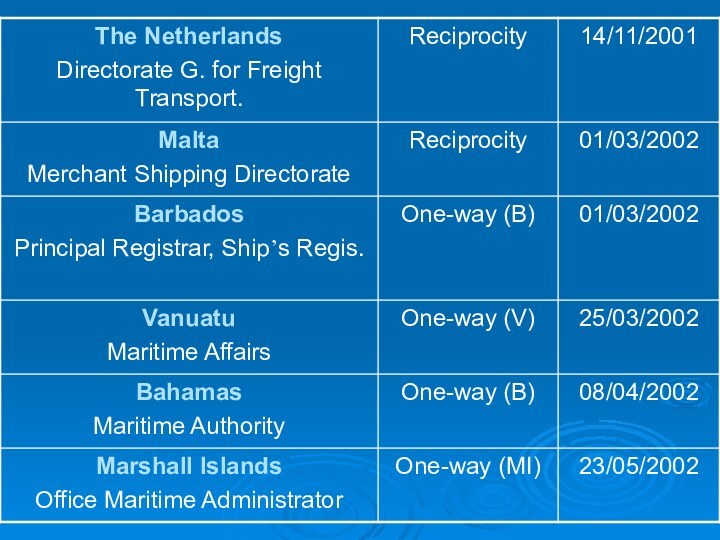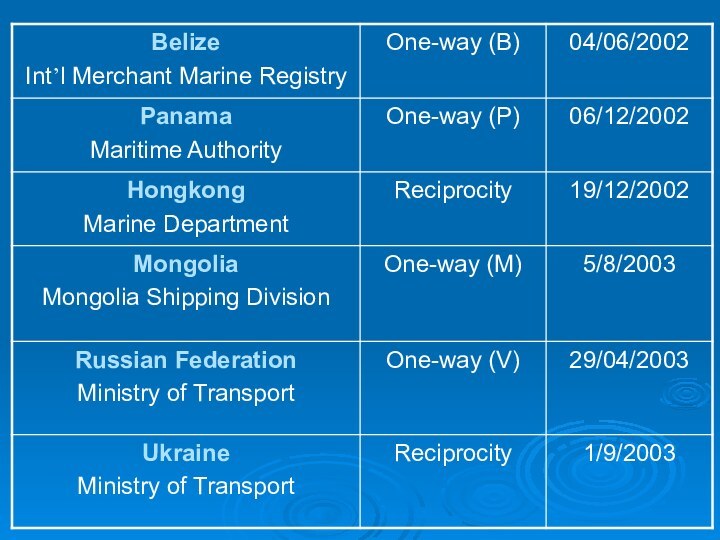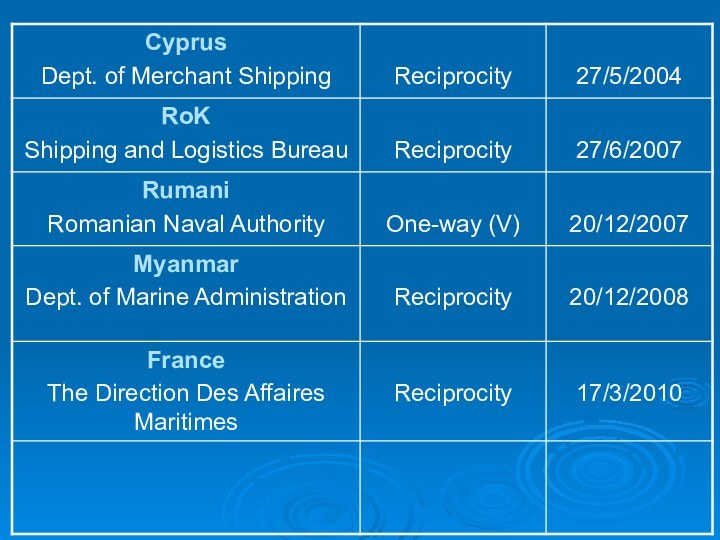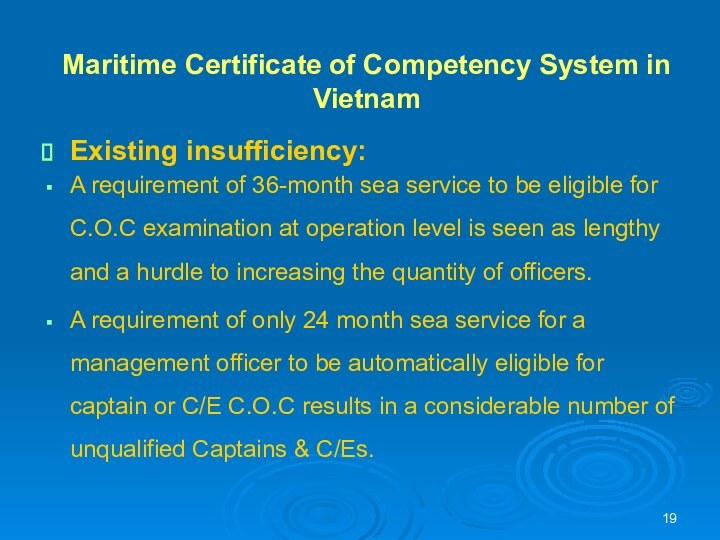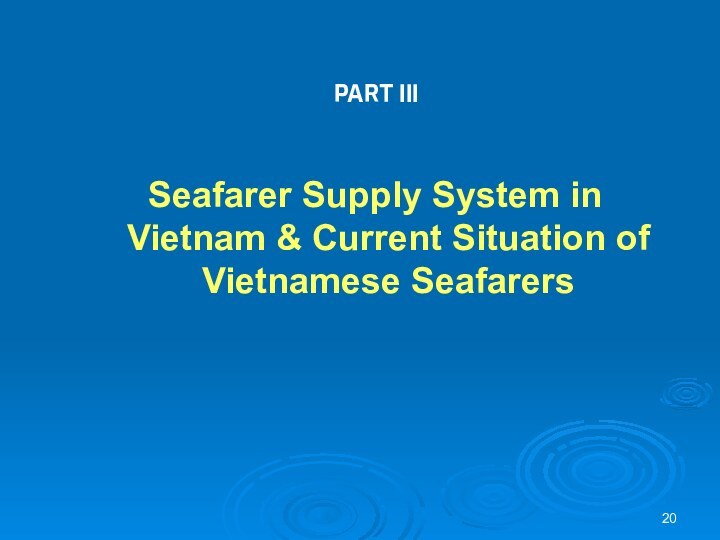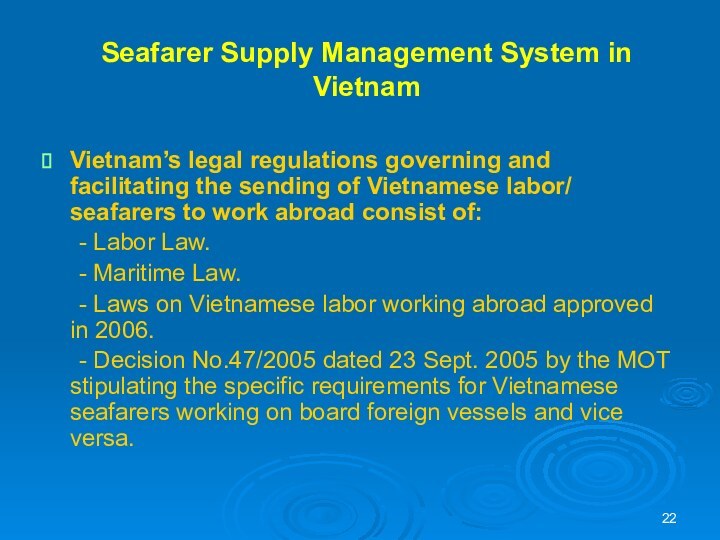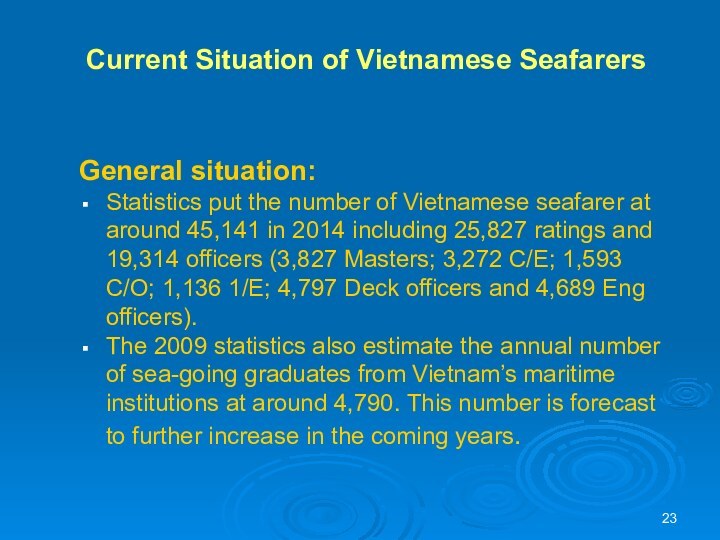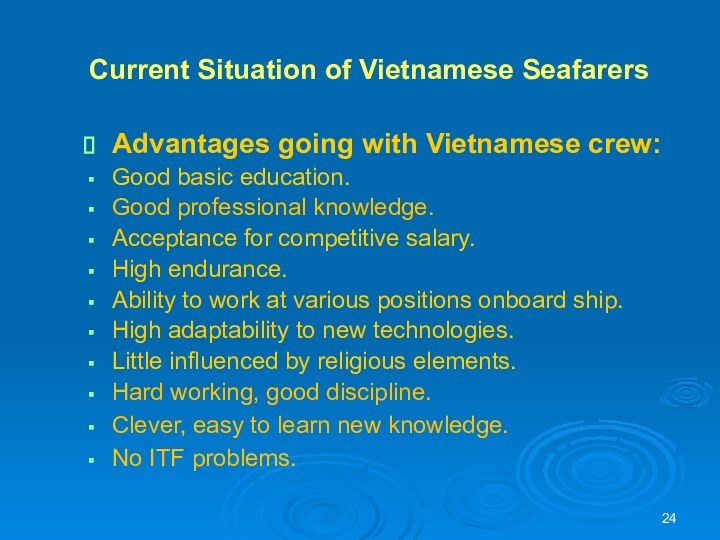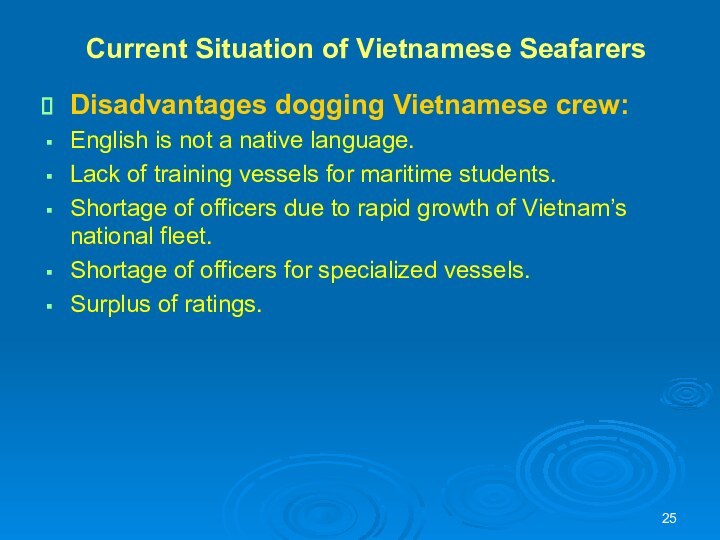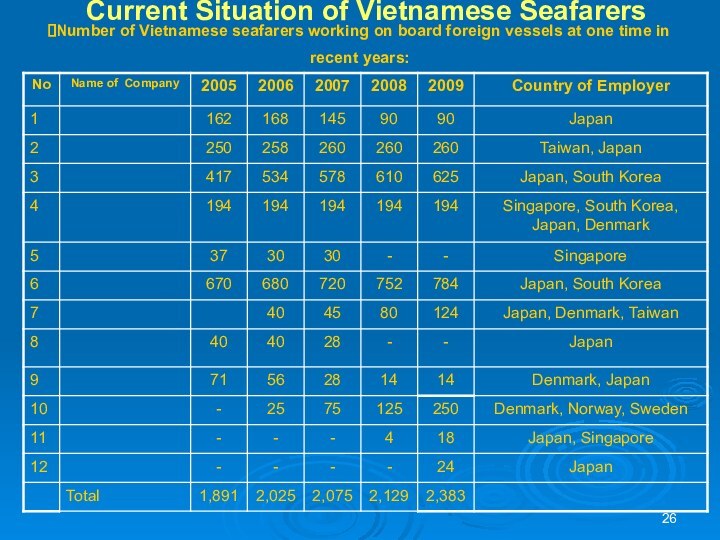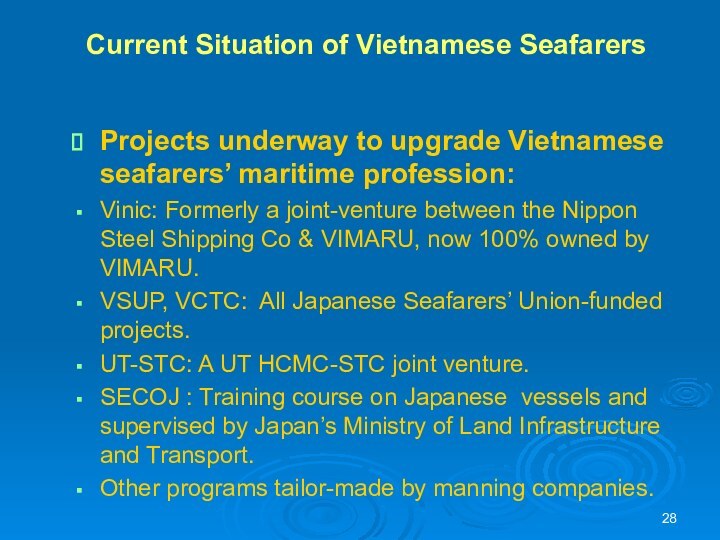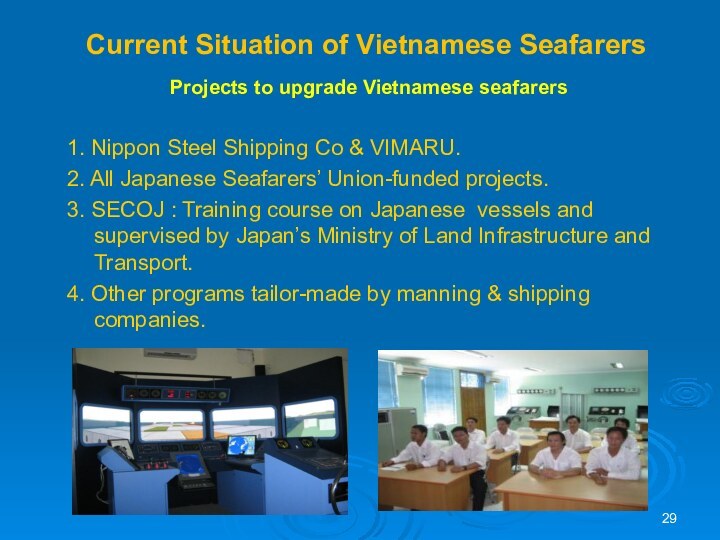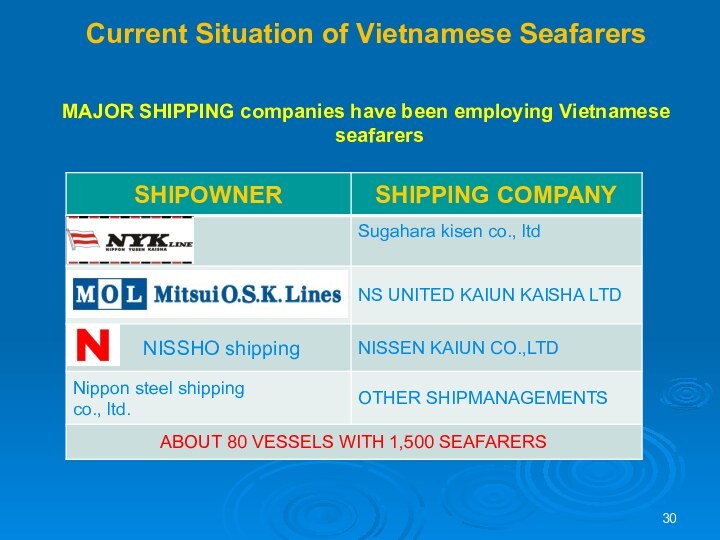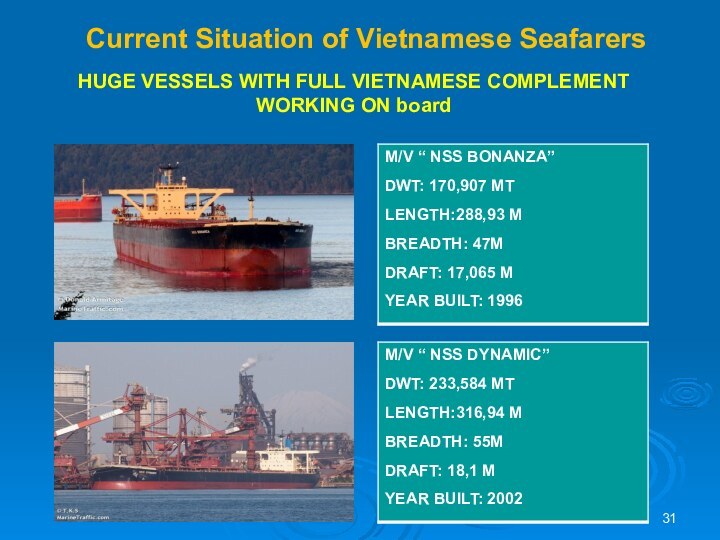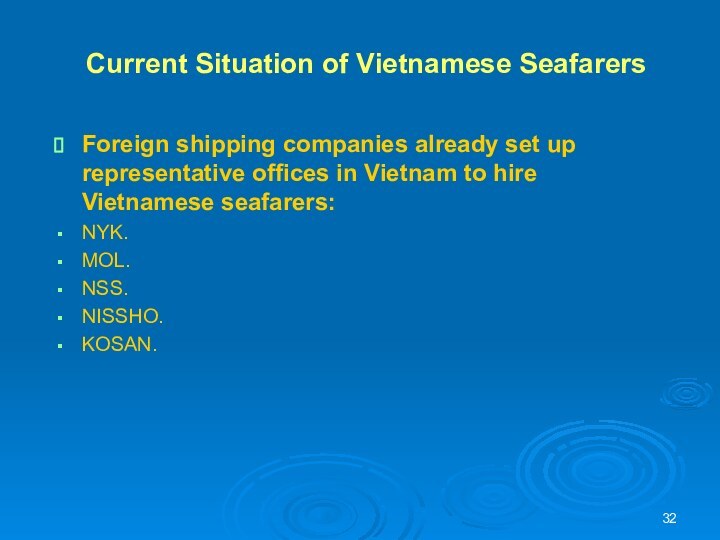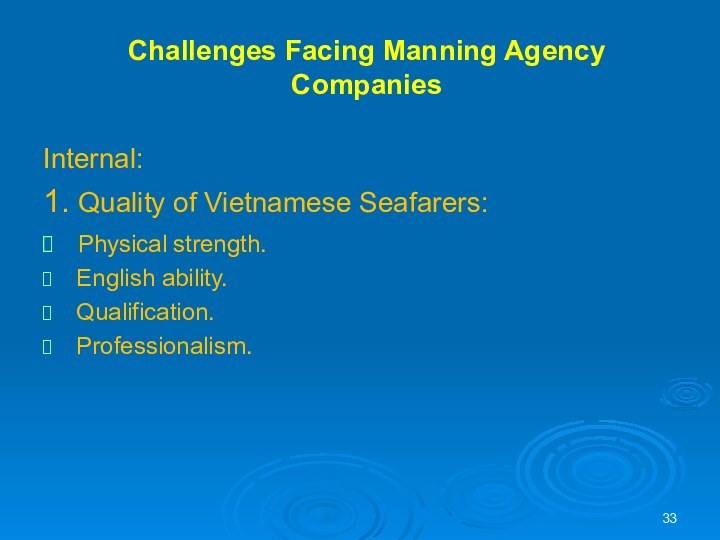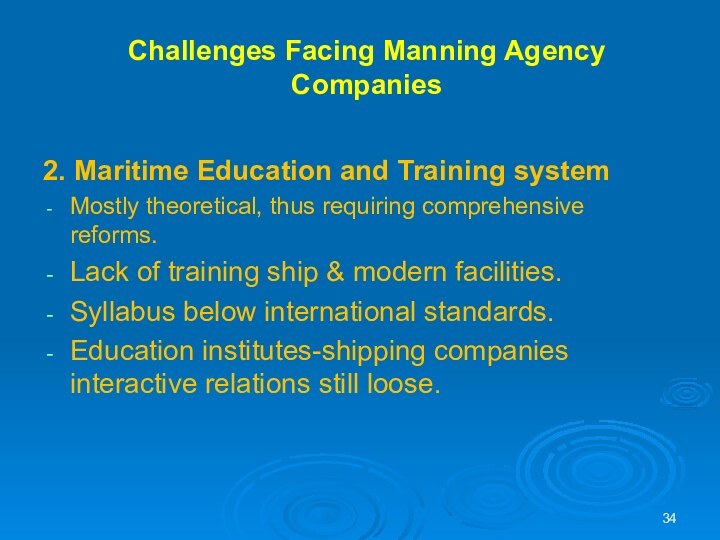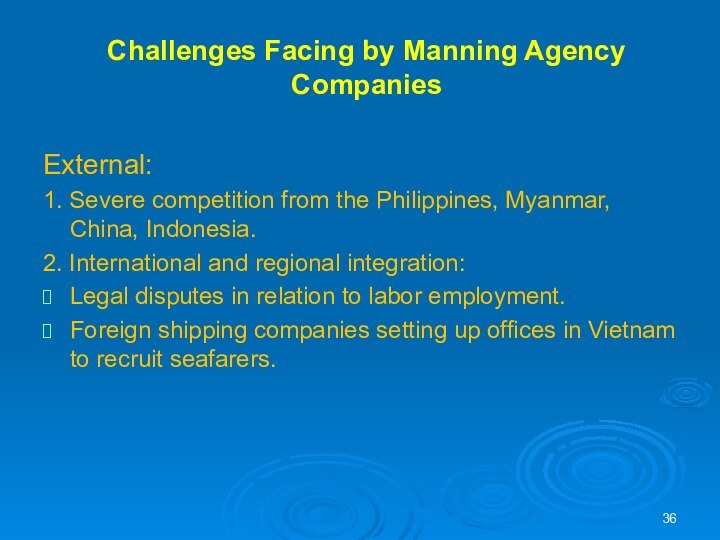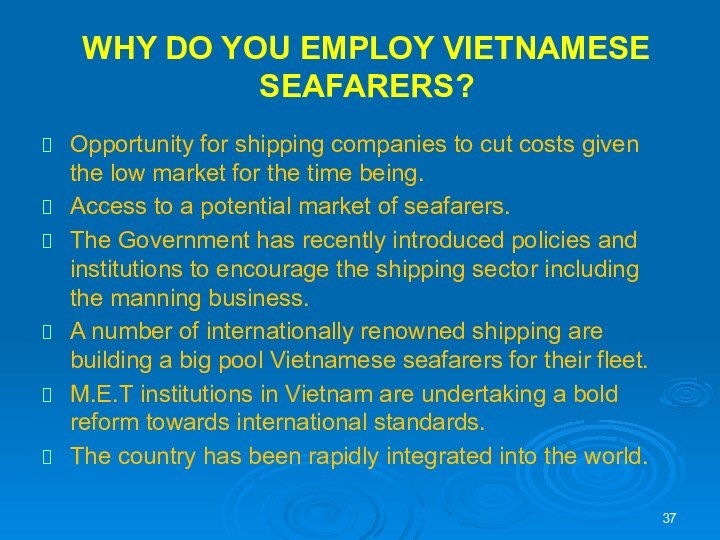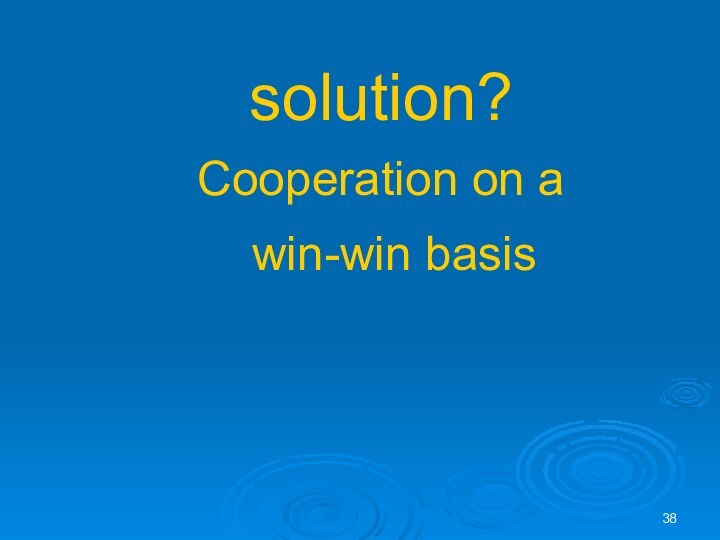Слайд 2
Presentation structure
Part I : Maritime education &
training institutions in
Vietnam
Part II : Maritime certificate of
competency system in Vietnam
Part III : Seafarer supply system in Vietnam & current situation of Vietnamese seafarers
Слайд 3
PART I
Maritime Education & Training Institutions in
Vietnam
Слайд 4
Maritime education & training institutions
in Vietnam
Maritime institutes in Vietnam:
1. Vietnam Maritime
University (VIMARU).
2. HCM City University of Transport (UT-HCMC).
3. Maritime College No. 1 in Hai Phong.
4. Maritime College No. 2 in Ho Chi Minh.
5. Hai Phong Polytechnics Vocational College.
6. Duyen Hai Vocational College.
Слайд 5
Structure of M.E.T Institutions in Vietnam
MINISTRY OF TRANPORT
MINISTRY
OF EDUCATION AND TRAINING
VIETNAM MARITIME
UNIVERSITY (VIMARU)
HCM CITY UNIVERSITY
OF TRANSPORT (UT-HCMC)
VIETNAM MARITIME
ADMINISTRATION
MARITIME COLLEGE
NO.1
MARITIME COLLEGE
NO.2
HAIPHONG POLYTECHNICS
VOCATIONAL COLLEGE
DUYEN HAI VOCATIONAL
COLLEGE
Слайд 6
Education and Training Flow
Vietnam Maritime University
Engineer and Bachelor
Degrees
3 months preparation for Final Exams.
1.5 year study professional
subjects
2 years study fundamental subjects
Entrant Examination (Math, Physics, Chemistry)
Candidates (Upper Secondary School)
4.5 YEARS DURATION
Diploma Degrees
3 months preparation for Final Exams.
1 year study professional subjects
1.5 years study fundamental subjects
Entrant Examination (Math, Physics, Chemistry)
Candidates (High School)
3.5 YEARS DURATION
Training
Training
Training
Слайд 7
SYSTEM OF EDUCATION AND TRAINING
VIETNAM MARITIME UNIVERSITY
+ Faculty
of Navigation
+ Faculty of Marine Engineering
+ Faculty of Marine
Electrical & Electronic Engineering
+ Faculty of Sea Transport Economics
+ Faculty of Shipbuilding
+ Faculty of Waterway Engineering
+ Faculty of Information Technology
+ Department of Post Education
+ Department of Basic Education
Refreshing and Upgrading courses for Operational and Management-level maritime officers and engineers
Basic and Advanced Safety Training Courses
Special Training Courses
+ RADAR/ARPA Simulator
+ GMDSS Simulator (GOC)
+ Other Simulator Training Courses
+ Oil tanker, LNG&LPG Carriers, Passenger vessels
- Skill training courses (laboratories, mechanical workshops and/or training ship)
Education
Training
Graduation Degrees
Training Certificates
Слайд 8
Maritime Education & Training Institutions in Vietnam
Number of
maritime graduates in 2009:
Слайд 10
Maritime Education & Training Institutions in Vietnam
Supplementary information:
Vietnam
has been in the White List since the year
2000.
Modern new methods of teaching have been introduced in education and training towards better adapting to the STCW standards.
More practical training has been applied, with theoretical education reduced.
As a result, Vietnam’s M.E.T capacity has been given a boost.
Слайд 11
Maritime Education & Training Institutions in Vietnam
Existing insufficiency:
The
curriculum is mostly based on theory with little practical
training.
The theoretical education is lengthy with some subjects becoming inappropriate in comparison with international standards.
Lack of training vessels and simulation systems.
Teaching staff are short of state of the art expertise.
Слайд 12
PART II
Maritime Certificate of Competency System in
Vietnam
Слайд 13
THE MARITIME C.O.C SYSTEM IN VIETNAM
CAPTAIN, CHIEF ENGINEER
3/O-3/E
2/O-2/E*
C/O-2/E
CERTIFICATE
OF COMPETECY
( Management Level)
UPGRADING COURSE AT VIMARU OF UTHCMC
( O4 months)
CERTIFICATE OF COMPETECY
( Operation Level)
REFRESHING COURSE AT VIMARU
( 80 hours = 3 weeks)
12 MONTHS AS OFFICER TRAINEE
( Training record book required)
VIMARU, UT-HCMC GRADUATES
( Engineer = 4.5 years)
VIMARU, UT-HCMC GRADUATES
( Diploma = 3.5 years)
12 MONTHS AS OFFICER TRAINEE
( Training record book required)
REFRESHING COURSE AT VIMARU
( 80 hours = 3 weeks)
CERTIFICATE OF COMPETECY
( Operation Level)
UPGRADING COURSE AT VIMARU OF UT-
HCMC( O4 months)
CERTIFICATE OF COMPETECY
( Management Level)
C/O-2/E
CAPTAIN, CHIEF ENGINEER
2/O-2/E*
3/O-3/E
FIRST CLASS
SECOND CLASS
UPGRADING
(2 years)
UPGRADING
(2 years)
Examination
Examination
Examination
Examination
24 months
24 months
12 months
12 months
12 months
12 months
Слайд 14
Maritime Certificate of Competency System in Vietnam
Supplementary information:
Vietnam
Maritime Administration has signed agreements on mutual recognition of
STCW certificates with different 20 countries & territories.
Some foreign Maritime Administration are considering cooperation with Vietnam in certification for seafarers.
Слайд 19
Maritime Certificate of Competency System in Vietnam
Existing insufficiency:
A
requirement of 36-month sea service to be eligible for
C.O.C examination at operation level is seen as lengthy and a hurdle to increasing the quantity of officers.
A requirement of only 24 month sea service for a management officer to be automatically eligible for captain or C/E C.O.C results in a considerable number of unqualified Captains & C/Es.
Слайд 20
PART III
Seafarer Supply System in Vietnam & Current
Situation of Vietnamese Seafarers
Слайд 21
Seafarer Supply Management System in Vietnam
Слайд 22
Seafarer Supply Management System in Vietnam
Vietnam’s legal regulations
governing and facilitating the sending of Vietnamese labor/ seafarers
to work abroad consist of:
- Labor Law.
- Maritime Law.
- Laws on Vietnamese labor working abroad approved in 2006.
- Decision No.47/2005 dated 23 Sept. 2005 by the MOT stipulating the specific requirements for Vietnamese seafarers working on board foreign vessels and vice versa.
Слайд 23
Current Situation of Vietnamese Seafarers
General situation:
Statistics put the
number of Vietnamese seafarer at around 45,141 in 2014
including 25,827 ratings and 19,314 officers (3,827 Masters; 3,272 C/E; 1,593 C/O; 1,136 1/E; 4,797 Deck officers and 4,689 Eng officers).
The 2009 statistics also estimate the annual number of sea-going graduates from Vietnam’s maritime institutions at around 4,790. This number is forecast to further increase in the coming years.
Слайд 24
Current Situation of Vietnamese Seafarers
Advantages going
with Vietnamese crew:
Good basic education.
Good professional knowledge.
Acceptance for competitive
salary.
High endurance.
Ability to work at various positions onboard ship.
High adaptability to new technologies.
Little influenced by religious elements.
Hard working, good discipline.
Clever, easy to learn new knowledge.
No ITF problems.
Слайд 25
Current Situation of Vietnamese Seafarers
Disadvantages dogging Vietnamese crew:
English
is not a native language.
Lack of training vessels for
maritime students.
Shortage of officers due to rapid growth of Vietnam’s national fleet.
Shortage of officers for specialized vessels.
Surplus of ratings.
Слайд 26
Current Situation of Vietnamese Seafarers
Number of Vietnamese seafarers
working on board foreign vessels at one time in
recent years:
Слайд 27
Current Situation of Vietnamese Seafarers
Taiwanese and Japanese Shipping
companies are major employers of Vietnamese Seafarers.
Vietnamese seafarers are
catching up with international standards.
It is estimated by 2010 up to 4,000 Vietnamese Seafarers would be working onboard foreign vessels at one time.
Слайд 28
Current Situation of Vietnamese Seafarers
Projects underway to upgrade
Vietnamese seafarers’ maritime profession:
Vinic: Formerly a joint-venture between the
Nippon Steel Shipping Co & VIMARU, now 100% owned by VIMARU.
VSUP, VCTC: All Japanese Seafarers’ Union-funded projects.
UT-STC: A UT HCMC-STC joint venture.
SECOJ : Training course on Japanese vessels and supervised by Japan’s Ministry of Land Infrastructure and Transport.
Other programs tailor-made by manning companies.
Слайд 29
Current Situation of Vietnamese Seafarers
Projects to upgrade Vietnamese
seafarers
1. Nippon Steel Shipping Co & VIMARU.
2. All Japanese
Seafarers’ Union-funded projects.
3. SECOJ : Training course on Japanese vessels and supervised by Japan’s Ministry of Land Infrastructure and Transport.
4. Other programs tailor-made by manning & shipping companies.
Слайд 30
Current Situation of Vietnamese Seafarers
MAJOR SHIPPING companies
have been employing Vietnamese seafarers
Слайд 31
Current Situation of Vietnamese Seafarers
HUGE VESSELS WITH
FULL VIETNAMESE COMPLEMENT WORKING ON board
Слайд 32
Current Situation of Vietnamese Seafarers
Foreign shipping companies
already set up representative offices in Vietnam to hire
Vietnamese seafarers:
NYK.
MOL.
NSS.
NISSHO.
KOSAN.
Слайд 33
Challenges Facing Manning Agency Companies
Internal:
1. Quality of Vietnamese
Seafarers:
Physical strength.
English ability.
Qualification.
Professionalism.
Слайд 34
Challenges Facing Manning Agency Companies
2. Maritime Education and
Training system
Mostly theoretical, thus requiring comprehensive reforms.
Lack of training
ship & modern facilities.
Syllabus below international standards.
Education institutes-shipping companies interactive relations still loose.
Слайд 35
Challenges Facing Manning Agency Companies
3. Increasing wastage rate
Qualified
senior officers quitting to seek shore-based jobs.
Young maritime graduates
choosing to work ashore.
Слайд 36
Challenges Facing by Manning Agency Companies
External:
1. Severe competition
from the Philippines, Myanmar, China, Indonesia.
2. International and regional
integration:
Legal disputes in relation to labor employment.
Foreign shipping companies setting up offices in Vietnam to recruit seafarers.
Слайд 37
WHY DO YOU EMPLOY VIETNAMESE SEAFARERS?
Opportunity for shipping
companies to cut costs given the low market for
the time being.
Access to a potential market of seafarers.
The Government has recently introduced policies and institutions to encourage the shipping sector including the manning business.
A number of internationally renowned shipping are building a big pool Vietnamese seafarers for their fleet.
M.E.T institutions in Vietnam are undertaking a bold reform towards international standards.
The country has been rapidly integrated into the world.
Слайд 38
solution?
Cooperation on a win-win basis
